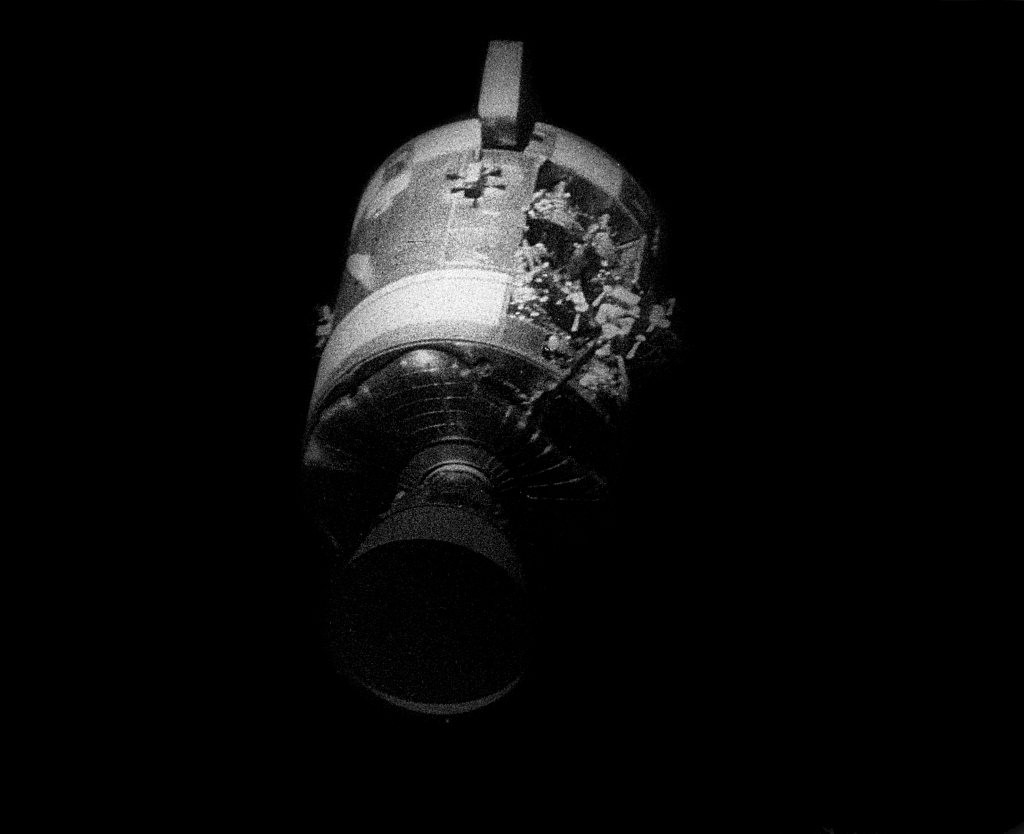
By the middle of April 1970, Project Apollo—America’s effort to land a man on the lunar surface—had reached one of its most decisive points of crisis. As described in yesterday’s AmericaSpace history article, an explosion rocked the Apollo 13 spacecraft, halfway to the Moon, destroying one oxygen tank, puncturing the second, and effectively crippling both the mission and its crew of Commander Jim Lovell, Command Module Pilot (CMP) Jack Swigert, and Lunar Module Pilot (LMP) Fred Haise. If Lovell had been asked, before liftoff, what the chances of survival might have been in such a dire situation, his response would have comprised just one word: “Nil.” Yet within hours of the explosion, a heroic rescue plan was conceived between the astronauts and Mission Control. It carried tremendous risk, yet promised the greatest possible return: the survival of the crew.
On the evening of 14 April, one of the most critical events in that plan got underway. Two hours after making their closest approach to the Moon (properly termed “pericynthion”), the plan called for the astronauts to perform a long burn of the lunar module Aquarius’ descent engine. This engine would ordinarily have been used to carry Jim Lovell and Fred Haise down to the surface, but was now being employed for a more important role of salvation. Since it occurred two hours after pericynthion, the burn was nicknamed “PC+2.” Lovell was worried about the burn. More than 20 hours had elapsed since Aquarius had taken over navigational control of Apollo 13 from the command module Odyssey, and he was concerned that its platform might have significantly “drifted.” Significantly, the debris field all around them meant that star sightings were virtually impossible, unless conducted in the Moon’s shadow, and time would not be on their side. At this stage, Capcom Charlie Duke radioed up instructions for a solution. They were to use the only star that they could see clearly—the Sun—to make an alignment sighting. It worked.
The PC+2 burn duly took place at 8:40 p.m. CDT on the 14th and lasted for 4.5 minutes, effectively cutting a sizeable chunk of time off Apollo 13’s return journey and committing Odyssey to a splashdown in the mid-Pacific on the 17th. Conditions, though, were still dire. The three men were living in the lunar module’s ascent stage cabin, which was about the size of a small broom cupboard. Moreover, many of the lander’s systems had been shut down in anticipation of the PC+2 burn and temperatures fell dramatically. Odyssey itself had been cold almost a full day and since there was no way to close the connecting hatches, the large volume was too big to keep warm. “We got clammy,” Lovell wrote in his autobiography, Lost Moon. “Moisture started to form on the metal pieces of the spacecraft and all the couches and the windows were foamed up and running with water. It was not a very pleasant journey.”
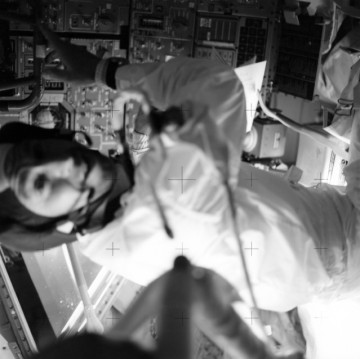
Every so often, one of them might retreat to the darkened Odyssey to catch some sleep, but this was almost impossible in an environment which could only be compared to a dark, dank cellar. None of the men could eat properly. On one occasion, Swigert went to fetch some foil-wrapped hot dogs from the food locker … only to find them frozen solid! Limited water supplies meant that the crew quickly became dehydrated, and the risk of nudging Apollo 13 off-course meant that they could no longer perform urine dumps out of the side of the spacecraft.
By the time they got back to Earth, their dehydration would be severe and Fred Haise was found to have developed a kidney infection. Before launch, the flight surgeons warned the astronauts that if they did not consume and pass sufficient water during the mission, their bodies could not excrete toxins, which, in turn, would accumulate in their kidneys. The resultant infection remained with Haise throughout the return journey, manifesting itself in a burning sensation whenever he urinated. (After splashdown, he would be whisked to the infirmary and would be conspicuously absent from many of the post-flight tours, including a tickertape parade in Chicago.)
Still, home beckoned. By the morning of 17 April, Mission Control knew that the crisis had reached its last major stage: for they had to somehow revive the command module Odyssey from almost four days in deep freeze and bring its systems back to life for the fiery, 25,000 mph (40,000 km/h) descent through the atmosphere. Its controllability had to be precise, its parachutes had to deploy perfectly and on schedule … and yet, with moisture dripping from every surface, there was no way of knowing if it would even power back up, let alone avoid some form of electrical short. Jim Lovell was not alone in his fear that moisture lurked behind Odyssey’s control panels, and he considered it inevitable that they would experience problems.
The man in charge of reactivating Odyssey was Jack Swigert. He knew that the process had to occur in a specific sequence, and he also knew that re-entry could not be postponed, so it had to happen perfectly, first time. Normally, it took three months to write a detailed, step-by-step, circuit-breaker-by-circuit-breaker checklist for re-entry. Now, however, the systems maestros in Mission Control had devised the procedures for Swigert in less than two days. Instrumental in this remarkable process were White Team Flight Director Gene Kranz and his men, who had formed a “tiger team” shortly after the explosion to plan everything from the PC+2 burn to the platform alignment to mid-course corrections to the procedures for re-entry. Within Kranz’ team were three groups: the first wrote instructions for each procedure, the second translated those instructions into checklists for the crew, and the third ensured that none of the steps would overwhelm the meager power levels of Odyssey or Aquarius.
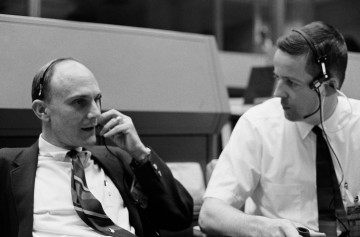
One mid-course correction, to keep the spacecraft on a perfect course, had been performed late on 15 April. Lovell was instructed to orient Apollo 13, such that the Sun shone directly through Aquarius’ overhead rendezvous window; he would rotate the entire spacecraft “stack” until the crescent Earth appeared in his forward triangular window. When the “horns” of the crescent touched the crosshairs of the window, Lovell would burn the descent engine for 14 seconds. With Lovell in control, Haise maintaining orientation in pitch, and Swigert tracking the time, the burn had been perfect … and all the more remarkable for three exhausted, cold, and mentally depleted men.
Back on the ground, Apollo 13 backup crewmen John Young and Charlie Duke, together with Apollo 14 backups Gene Cernan and Joe Engle, had busily rehearsed procedures in the lunar module simulator, whilst Ken Mattingly had sweated the details of the re-entry checklist in the command module simulator. Had it not been for exposure to German measles, Mattingly might have been aboard Apollo 13 himself. His role now was to ensure the Odyssey’s switches were thrown in exactly the right order and systems reactivated in precisely the right way to avoid overstressing the batteries. Lovell knew and trusted Mattingly implicitly and had been furious when the measles incident had grounded him; now he used a series of code words to Mission Control to find out if his former crewmate had come down with measles. One exchange between Lovell and Gold Team Capcom Vance Brand garnered some humor.
“Are the flowers in bloom in Houston?” Lovell asked, pointedly.
“Nope, not yet,” replied Brand. “Still must be winter.”
“Suspicions confirmed.”
At 7:30 p.m. CDT on the 16th, Mattingly finally walked into Mission Control, carrying a sheaf of papers, detailing every power-up and re-entry procedure for Odyssey’s systems. He sat down next to Brand and plugged his headset into the Capcom’s loop. “Hello, Aquarius, Houston. How do you read?”
“Okay,” replied a clearly happy Swigert. “Very good, Ken.”
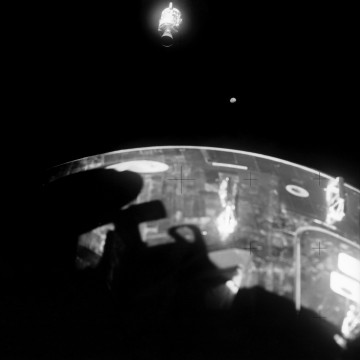
“Let me take it from the top here.” For the next two hours, Mattingly and Swigert plunged into a 39-page, 400-step checklist, which established every switch throw and keystroke needed to bring Odyssey back from the dead. Tiredness and dehydration had already led to the astronauts making mistakes. Even flight-experienced Lovell had accidentally called up the computer program for Aquarius’ descent engine at one stage, instead of the maneuvering thrusters, and Swigert knew that every step was crucial. In fact, no step was more crucial than jettisoning the crippled service module, and Swigert worried that he might eject the wrong module—Aquarius—by mistake, with his crewmates still inside. It might sound foolish, but one must bear in mind that all three men were exhausted, hungry, thirsty, cold, and well aware that, despite all their efforts, there was only a slim chance of survival. To make sure that he did not screw up, Swigert taped a bit of paper over the toggle switch for LM JETTISON. The note to himself read simply: “No.” He triple-checked it and invited a bemused Haise aboard to verify that it was correct.
At 7:16 a.m. CDT on the 17th, he pushed the SM JETTISON button and heard the unmistakable bang of exploding pyrotechnics. In the moments that followed, the true extent of what they had endured for four days became horrifyingly apparent.
Clearly visible in the glint of harsh sunlight, the service module rotated its damaged side panel into their line of sight. All three men gasped and shot photograph after photograph. “There’s one whole side of that spacecraft missing,” reported an astonished Lovell. Capcom Joe Kerwin’s efforts to make light of the situation—quipping that Lovell should have taken better care of his ship—fell on deaf ears. A massive panel, some 13 feet (4 meters) long and covering a sixth of the service module’s hull, was gone, leaving nothing but shredded wires and a jumble of fractured plumbing. The S-band antenna had been bent out of position and the damage did impair the giant SPS engine … and, worryingly, did extend right up to the ring which supported the base of Odyssey itself. And that base carried something of vital importance: the heat shield, which would be the command module’s only defense against the furnace of re-entry.
Nothing could be done but wait and hope. As the clocks struck 10 in Houston that morning, Swigert and Haise worked through the final power-up procedures inside Odyssey, their eyes keenly on the lookout for sparks and their noses tuned to the slightest trace of smoke in the chilled air. Against all odds, everything ran smoothly. With all three men buttoned up inside the command module, Swigert jettisoned Aquarius. Years later, their last glimpse of the “good ship” drifting away into the inky blackness would bring sorrow, and Haise wished that it could have been brought home and put into a museum. Alas, Aquarius had no heat shield and its fate would be a fiery Viking funeral, plunging back to Earth in a shower of burning debris.
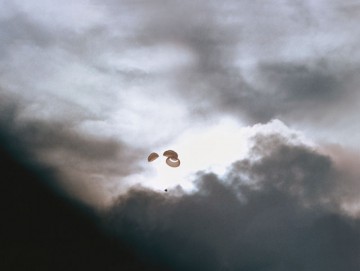
Alone now, the cone-shaped command module plunged homeward at a lunar-return velocity of 25,000 mph (40,000 km/h), hitting the upper atmosphere at 11:53 a.m. CDT. Shortly thereafter, a sheath of super-heated plasma blocked out radio communications for an anticipated three minutes. Much has been written of the over-hyped drama of Ron Howard’s movie, Apollo 13, but his depiction of the raw, pervasive fear in Mission Control during this silent time is very close to reality.
Only Joe Kerwin’s voice punctured the silence.
“Odyssey, Houston,” he radioed. “Standing by.”
Silence reigned, both from the returning crew and in Mission Control. Fuzzy television views of a desolate stretch of the Pacific Ocean showed nothing. Recovery forces from the amphibious assault ship Iwo Jima—including a detachment of U.S. Marine Corps helicopters—had already been scrambled as part of Task Force 130, the massive search and rescue operation for Apollo 13.
Three minutes stretched agonizingly to four. Odyssey had re-entered the atmosphere at a slightly different angle than predicted, meaning that the communications blackout was somewhat longer. That time difference now seemed interminable.
At length, a Boeing EC-135 aircraft, specially modified for telemetry and tracking, reported that it had acquired a signal from the rapidly descending Odyssey … but there was still no word from the astronauts.
“Odyssey, Houston,” Kerwin repeated. “Standing by.”
Silence.
Then, a slight change in the nature of the static occurred. And then came a voice. It was Jack Swigert. “Okay, Joe.” Still there could be no release of tension: not until the parachutes deployed, and deployed successfully, could it be known that the astronauts were home safe. Seconds later, a television camera aboard the Iwo Jima picked up the dark cone of the command module, hanging beneath three parachutes, amongst the clouds. It was then that everyone in Mission Control applauded.
“Odyssey, Houston, we show you on the mains,” yelled Kerwin, as the television screen revealed the great orange-and-white canopies of the main chutes. “It really looks great!”
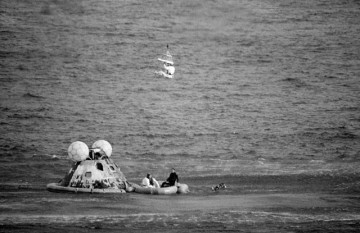
Splashdown at 12:07 p.m. CDT—10:07 a.m. in the Pacific—was smooth. Forty-five minutes later, the three astronauts were safely aboard the Iwo Jima. Bearded, pale, and exhausted, they stood on the deck, listening to the cheers of the ship’s crew and a rousing rendition of Aquarius by its military band.
In the days that followed, the men would receive the Presidential Medal of Freedom, the nation’s highest civilian honor, and, perhaps equally fittingly, the heroes of the Mission Operations Team—represented by Apollo 13’s four flight directors, Gene Kranz, Glynn Lunney, Milt Windler, and Gerry Griffin—were similarly acknowledged. “Three brave astronauts,” intoned President Richard M. Nixon, as he gave the awards, “are alive and on Earth because of their dedication and because, at the critical moments, the people of that team were wise enough and self-possessed enough to make the right decisions. Their extraordinary feat is a tribute to man’s ingenuity, to his resourcefulness and to his courage.”
Never were more accurate words spoken. Apollo 13’s greatest legacy is that it demonstrated the capabilities and heroism of the entire NASA team. Of these, the astronauts had performed admirably under the most extreme duress, but Nixon’s words paid tribute to the unsung heroes, represented at the podium by the four flight directors. Most visible were heroes such as Ed Smylie, whose team built the carbon dioxide scrubber, and Ken Mattingly, who recoiled from crushing disappointment to play a vital role in saving the mission, and Sy Liebergot, one of the first to comprehend the enormity of the accident and begin steps to respond to it. Yet thousands more worked behind the scenes, giving up sleep, sustenance, and time with their families to go to their offices, by day and by night, for four solid days, to save three men’s lives.
In his 1995 movie, Ron Howard has Gene Kranz, played by actor Ed Harris, utter the immortal words: “This was our finest hour.” Indeed it was.
This is part of a series of history articles, which will appear each weekend, barring any major news stories. Next week’s article will focus on the 25th anniversary of STS-31, the epochal shuttle mission which deployed the Hubble Space Telescope (HST) in April 1990.
Want to keep up-to-date with all things space? Be sure to “Like” AmericaSpace on Facebook and follow us on Twitter: @AmericaSpace




5 Comments
5 Pings & Trackbacks
Pingback:SpaceX, NASA Discuss Forthcoming Dragon Pad Abort Test « AmericaSpace
Pingback:Sleeping On Alien Shores: The Unquiet Slumbers of the Apollo Moonwalkers « AmericaSpace
Pingback:‘A Nation of Quitters': 45 Years Since the Summer Apollo Ended (Part 1) « AmericaSpace
Pingback:‘A Nation of Quitters': 45 Years Since the Summer Apollo Ended (Part 2) « AmericaSpace
Pingback:Record Breaker: Scott Kelly Becomes Most Experienced U.S. Astronaut Tomorrow « AmericaSpace